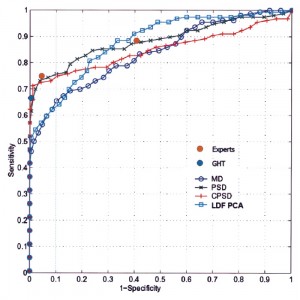Goldbaum MH, Sample PA, Chan K, Williams J, Lee TW, Blumenthal E, Girkin CA, Zangwill LM, Bowd C, Sejnowski T, Weinreb RN.
Invest Ophthalmol Vis Sci. 2002 Jan;43(1):162-9.
Ophthalmic Informatics Laboratory, Department of Ophthalmology, University of California at San Diego, La Jolla, California, USA. mgoldbaum@ucsd.edu
ABSTRACT:
PURPOSE: To determine which machine learning classifier learns best to interpret standard automated perimetry (SAP) and to compare the best of the machine classifiers with the global indices of STATPAC 2 and with experts in glaucoma.
METHODS: Multilayer perceptrons (MLP), support vector machines (SVM), mixture of Gaussian (MoG), and mixture of generalized Gaussian (MGG) classifiers were trained and tested by cross validation on the numerical plot of absolute sensitivity plus age of 189 normal eyes and 156 glaucomatous eyes, designated as such by the appearance of the optic nerve. The authors compared performance of these classifiers with the global indices of STATPAC, using the area under the ROC curve. Two human experts were judged against the machine classifiers and the global indices by plotting their sensitivity-specificity pairs.
RESULTS: MoG had the greatest area under the ROC curve of the machine classifiers. Pattern SD (PSD) and corrected PSD (CPSD) had the largest areas under the curve of the global indices. MoG had significantly greater ROC area than PSD and CPSD. Human experts were not better at classifying visual fields than the machine classifiers or the global indices.
CONCLUSIONS: MoG, using the entire visual field and age for input, interpreted SAP better than the global indices of STATPAC. Machine classifiers may augment the global indices of STATPAC.
Figure from this article:

